
"Report to the Metropolitan Commission of Sewers on the house-drainage in St. James, Westminster during the recent cholera outbreak"
(22 September 1854)
[Courtesy of London Metropolitan Archives.]
On an Enquiry and Examination into the state of the drainage of the houses situate in that part of the Parish of St. James, Westminster, in which deaths have occurred from Cholera to so great an extent.
1, Greek Street,
22nd September, 1854.
With reference to this outbreak, which commenced in so virulent a form on the first of this month, and continued unabated for several days, taking off a large number of the occupants of the various houses, I beg, in order more readily to show the locality and the situation of these particular tenements, to submit the accompanying Plan [map] and Schedule [table]; the former showing at one view the houses affected, and the number of deaths which have occurred in each, together with the position of the various gullies and ventilating shafts with respect to the same; and the latter showing the description of the houses and state of drainage as nearly as could be ascertained.
By reference to the Plan it will be perceived that the disease has been most fatal in its character in Broad-street, a straight street, 50 feet wide, in part of which, between Cambridge-street and Marshall-street, a new sewer was built during the year 1851, with a fall southward towards Windmill-street. In the other portion of Broad-street, no works whatever have of late years been carried on, the sewer there having been built in the year 1823, which discharges itself into Berwick-street, and is entirely unconnected, and perfectly independent, of the sewer above alluded to, built in 1851. The drainage of many of the houses affected in this street is of a very defective character, cesspools no doubt existing at the rear of them, although closet-pans have been fixed. The number of the deaths which have occurred seems to [1/2] be equally divided between that part in which the sewer was built in 1851, and the part in which a sewer has existed ever since the year 1823, and where no sewerage works have been for some length of time executed; nor is there, as before stated, any communication whatever between the two lines, they having each a separate outlet into the Northumberland-street sewer, some three-quarters of a mile distant.
In the particular houses in this street where deaths have not taken place, it is satisfactory to be able to report that they are comparatively in an efficient state of drainage both into the new and old sewers, and without cesspools.
The next street which seems to have had most deaths is Berwick-street, a good straight street leading out of Oxford-street, and about 30 feet wide, in which exists an effective sewer perfectly free from deposit, and which was built part in the year 1822, and part in 1847; it has no communication whatever with those constructed last year in Little Marlborough-street, King-street, Marshall-street, etc.
The drainage of the houses in this street, as far as can be ascertained, is in anything but a satisfactory state; cesspools existing more or less along its whole length, with defective overflow brick drains.
In Great Pulteney-street, which is a straight wide street, and where many deaths have occurred, a new sewer was built in the beginning of this year, notwithstanding which, and the fact that the Commissioners, by a circular left at each house, invited the inhabitants to avail themselves of it, but two applications have been made to drain into it; consequently the drainage of the houses, forty-one in number, (with the exception of the two above-named) remains in the same imperfect state as it has been in ever since the houses were first built, with no doubt large cesspools in the rear, and old defective overflow brick drains.* (*Since writing this Report, I find that the accuracy of the opinion I expressed as to the probable existence of cesspools in Great Pulteney-street has been questioned, and I have been informed that the greater part of the cesspools in that street have been filled up. Without wishing to dispute the truth of this statement, I would only remark, that the opinion I expressed was founded on the practice which generally prevailed at the time the old house drains in Great Pulteney-street were constructed, namely, that of forming cesspools in connection with the drains, and that to have placed the house drainage on a proper footing, the old drains ought to have been taken up and replaced by new and effective pipe drains, laid at a proper inclination, and connected with the new sewer. The old drains themselves were, and are, a source of nuisance, they are square in form, built of brick, and have scarcely any inclination, and further, they are, for the most part, decayed. It was to the necessity of constructing new pipe drains to which the notice of the Commissioners called attention, and it is to this remedy I refer in the text; and, I conceive, my meaning cannot fail to be apparent to professional men. Great stress has been laid on the connection with the new sewer of the old defective house drainage, but this arrangement can never be considered as satisfactory; it necessarily takes place during the construction of the sewer, in order that the houses may not altogether be without drainage, until the new drains can be laid down and connected with the new sewer; but it can only be regarded as temporary.) This will apply in [2/3] about the same degree to the whole of the streets where the new sewers have been built, and which are in a perfect state and entirely free from deposit.
I would here beg to draw the attention of the Commissioners to the supposed position of the Plague pit, situate between King-street and Carnaby-street, and to the fact, that no deaths have occurred in Little Marlborough-street, which is pointed out to be in its centre, and through which a sewer was built last year, and the houses drained into it, as shown upon the Plan annexed.
I may state, that in the construction of the main sewers at the end of last and commencement of the present year, a drain mouth or eye, with flap, was left opposite to each house, but not a twentieth part of these drain mouths have yet been made use of.
The property in each street where old sewers existed, was to some extent drained into them by means of old defective brick drains, running from various premises, and acting as overflows from cesspools; and these, as the new sewers were built, have been connected with them; but nothing farther has been done, so that it may be said the house drainage of the locality remains in the same imperfect state as previous to the new sewers being built, with but very few exceptions.
It will be seen by the Plan, that the houses in which the great majority of deaths have taken place, are not situate opposite to gullies or ventilating shafts.
The total number of gullies in the locality is about 100, of which about half are trapped.
Since the outbreak, six men have been employed in these lines of sewers getting up information on this subject, all of whom, I am glad to state, are quite healthy, and entirely free from disease.
The number of houses inspected has been 207, in which are situate 218 water-closets, most of them fixed over cesspools, 20 open privies, 88 dust-bins in yards, 78 ditto in vaults or areas, and 25 in kitchens under the stairs; these dust-bins are kept in a comparatively clean state.
Throughout the neighbourhood, it is important to observe, that the houses are, for the most part, let out in lodgings; a separate family, and in some cases even two, are living on one floor, whereas but one water-closet, or privy in the yard or area, exists for the use of the whole house; consequently, in the rooms above the ground [3/4] floor, portable cesspools or slop pails are kept, into which night soil, dirty water, and all refuse are thrown, and these are emptied about once a day, either down a sink, or into the water-closet or privy, and not unfrequently into a gully in the street. On the top or attic floor, the occupants generally make use of the gutter for the emptying of the accumulations, which find their way down the rain water pipe on to the paving in the yard at the back of the house, and sometimes on to the footway in the street in front.
It is a fact worthy of notice, that the greatest mortality has taken place in the upper floors of nearly all the houses.
For a more minute description of the state of the drainage of the houses, I beg to refer to the accompanying Schedule.
The list of deaths therein enumerated, does not include very many cases where removal has taken place to the Hospitals, in which the disease has afterwards proved fatal.
In conclusion, I would recommend, in order as much as possible to guard against disease in future in this neighbourhood, that the parochial authorities should be invited to put in force the provisions of the Diseases' Prevention Act, in order that steps may be taken during the coming winter, to compel the owners of all property throughout the locality, to empty, fill up, and destroy the cesspools, fit up proper water-closets, lay on the water, and construct a pipe drain from each house into the sewer in front.
(Signed) EDMUND COOPER,
Engineer.
Metropolitan Commission of Sewers. Frontage Plan in the Parish of St. James, Westminster.
Full Map:
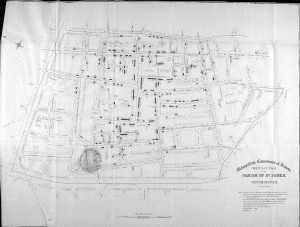
North West Quadrant:
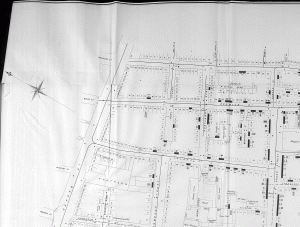
North East Quadrant:
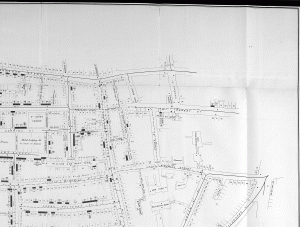
South West Quadrant:
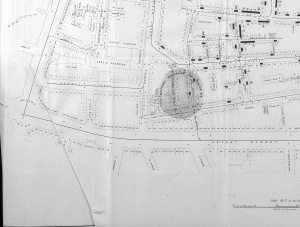
South East Quadrant:
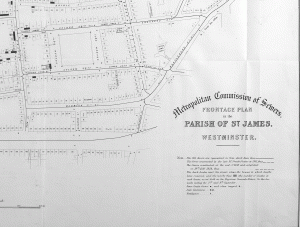
The Schedule showing findings for individual houses is posted to a companion web site.

 Home
Home